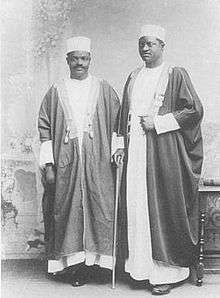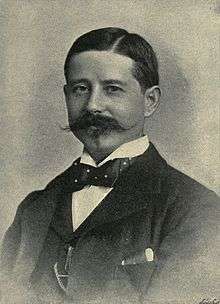Buganda Agreement (1900)
The Buganda Agreement (alternatively the Uganda Agreement or Treaty of Mengo) of March 1900 formalized the relationship between the Kingdom of Buganda and the British Uganda Protectorate.[1] It was amended by the Buganda Agreement of 1955 and Buganda Agreement of 1961.
 Buganda Kingdom Officials, 1890s | |
| Signed | March 10, 1900 |
|---|---|
| Location | Mengo |
| Negotiators | Alfred Robert Tucker |
| Signatories | H.H. Johnston, Apollo Kagwa, Stanislaus Mugwanya, Mbogo Noho, Zakaria Kizito |
| Parties | Kingdom of Uganda and England |
| Languages | Luganda and English |
Background
Prior to 1894, the local African political entities consisted of either chieftainships or kingdoms. The area that came to be known as Uganda was inhabited by many ethnic groups with distinct languages, cultures, traditions, and socio-political systems, the Kingdom of Buganda being the most powerful political entity in the region.[2]
The first direct contact between Uganda and the outside world came with the arrival of Arab Muslim traders from Zanzibar in 1884.[3] In 1877, the first missionaries from the Anglican Church of England arrived in Buganda, followed by the Roman Catholics two years later.[3] It was notable that the British colonial officials entered Uganda through a centralized kingdom rather than through a succession of disconnected societies, as they had elsewhere in eastern Africa.[3]
Their arrival in Buganda was complicated by the presence of Catholic and Protestant missionaries and the ensuing Buganda succession war of 1888-1892.[4] This religious-inspired civil war coincided with the imperial ambitions of Britain, which was trying to secure Uganda as its colony because of its importance with regard to access to the Nile.[3] During the war, British colonial officials, following chief agent Captain Frederick Lugard of the Imperial British East Africa Company (IBEAC)[3], lent their support to the Protestant faction led by chief minister (Katikiro) Apollo Kagwa.[4] Soon, the IBEAC relinquished its control over Uganda after the wars had driven it into bankruptcy.[3]
At the request of Sir Gerald Portal, Alfred Tucker, Bishop of Eastern Equatorial Africa and later Bishop of Uganda, urged the British authorities to take over Uganda.[2] On May 29, 1893, a treaty between Portal and Kabaka Mwanga informally ensured Uganda as a British Protectorate. On August 27, 1894, Mwanga was compelled to sign another treaty with Colonel H.E. Colvile, who encouraged conventional takeover of the territory.[3] Though the 1893 and 1894 treaties had been undertaken because, as stipulated by the Berlin Conference, Uganda happened to fall within the British sphere of influence, Britain lacked the sanctity of traditional rulers and their peoples. It was important that an agreement, as opposed to a treaty, be undertaken so that British rule would become de jure as opposed to being de facto.[3]
Agreement
The agreement was negotiated by Alfred Tucker, Bishop of Uganda,[5] and signed by, among others, Buganda's Katikiro Apollo Kagwa, on the behalf of the Kabaka (Daudi

Chwa) who was at that time an infant, and Sir Harry Johnston on the behalf of the British colonial government.
Buganda would henceforth be a province of the Protectorate, and would be transformed into a constitutional monarchy with the power of the Lukiiko (advisory council) greatly enhanced and the role of the Kabaka reduced.[1] The British also gained the right to veto future choices of the Kabaka, and control of numerous other appointments.[5] These provisions concerning the roles of the Kabaka and Lukiiko were largely reversed by the Buganda Agreement of 1961.[5]
The agreement stated that the Kabaka should exercise direct rule over the natives of Buganda administering justice through the Lukiiko and his officials.[6] It also solidified the power of the largely Protestant Bakungu client-chiefs, led by Kagwa. The British sent only a few officials to administer the country, relying primarily on the Bakungu chiefs. For decades they were preferred because of their political skills, their Christianity, their friendly relations with the British, their ability to collect taxes, and the proximity of Entebbe to the Buganda capital. By the 1920s the British administrators were more confident, and had less need for military or administrative support.[4]
By fixing the northern boundary of Buganda as the River Kafu, the agreement formalized Colvile's 1894 promise that Buganda would receive certain territories in exchange for their support against the Bunyoro.[1] Two of the 'lost counties' (Buyaga and Bugangaizi) were returned to the Bunyoro following the Ugandan lost counties referendum of 1964.[7]
Treaty Key Points
Unlike the 1893 and 1894 treaties, the 1900 Agreement included clear boundaries of the Buganda kingdom, a land tenure system, and taxation policies.[3]
Articles:[8]
- Outlines the boundaries of the Kingdom of Uganda,
- The Kabaka and chiefs renounce any claims to tribute on the adjoining provinces of the Protectorate in favor of the Her Majesty's Government;
- The Kingdom in the administration of the Uganda Protectorate holds equal ranking with any other provinces of the Protectorate;
- The revenue of the Kingdom will be merged with the general revenue of the Uganda Protectorate;
- The laws made by the Her Majesty's Government for the Uganda Protectorate will be equally applicable to the Kingdom, except when they are in conflict with the Agreement, in which case the Agreement will constitute a special exception;
- So long as the Kabaka, chiefs, and natives conform to the laws instituted by Her Majesty's Government, the Kabaka of Uganda will be recognized as the native ruler of the province;
- The Namasole Chua (mother of the present Kabaka), will be paid Ł50 a year that may not be continued to the mothers of other Kabakas;
- All cases where natives and non-natives are concerned are subject to British courts only;
- Establishes administrative counties;
- The Kabaka of Uganda may appoint three native Officers of State;
- Defines how the Lukiiko will be constituted;
- Establishes a taxation system;
- Nothing in the Agreement can be used to invalidate the preexisting right of the Kabaka to call upon every able-bodied male for military service, but the Kabaka may only exercise this power under the advice of Her Majesty's principal representative;
- All main public roads will be maintained in good repair by the chief of the Saza (county) through which the road runs;
- Establishes how the land of Uganda is to be distributed;
- The natives of Uganda may not have rights to the forests, but the Baganda may obtain timber for building and firewood;
- The rights to all minerals found on private estates belong to the owners of these estates. On the land outside these estates, the mineral rights belong to the Uganda Administration;
- The Kabaka, Regents, Katikiro, and Regents will be given a sum of money in return for the cession of the right of control over 10,550 square miles of land;
- Her Majesty's Government will pay the Mohammedan Uganda Chief, Mbogo, a pension of Ł250 a year, on the condition that he cedes all rights to Her Majesty's Government
- If the Kingdom fails to pay the Administration during the first two years after signing the Agreement, Her Majesty's Government will no longer be bound by the Agreement. If the revenue collected exceeds Ł45,000 a year, the Kabaka and chiefs may appeal for an increase in the subsidy given to the Kabaka;
- The phrase 'Uganda Administration' denotes the general government of the Uganda Protectorate. 'Her Majesty's representative' denotes the Commissioner, Higher Commissioner, Governor, or principal official;
- The English text is the version which is binding on both parties.
Consequences
In 1935, Sir Philip Mitchell came to Uganda as governor after serving in Tanganyika for the previous sixteen years. He was convinced that the relationship between Uganda and the protecting power should be of a character different from that between the native authorities and the Government of Tanganyika.[9] Recognizing that early Protectorate officials had produced a pattern of increasing suspicion and surreptitious changes, Mitchell devised a plan for the reform and remodeling of the system between the Protectorate and Buganda Governments.[10] Maintaining that the relationship between the Protectorate Government and the Native Government of Buganda was that of protected rather than indirect rule, he planned to substitute the post of Provincial Commissioner of Buganda with a Resident and to withdraw district officers from the center, assuming that the Kabaka would be obliged to follow advice given to him by the Resident and his staff.[9] Under the 1900 Agreement, however, the Kabaka was only required to act upon such advice in the case of the implementation of Lukiiko resolutions. Relations between the Kabaka, the Protectorate Government, and his Ministers deteriorated, and because of the Governor’s restricted power under the 1900 Agreement to impose his advice upon the Kabaka, the reorganization resulted in a steady decline in the influence that the Protectorate Government could exert in Buganda.[9]
References
- Reid, Richard J. (2 March 2017). A History of Modern Uganda. Cambridge University Press. pp. 158–160. ISBN 978-1-107-06720-2.
- Griffiths, Tudor. “Bishop Alfred Tucker and the Establishment of a British Protectorate in Uganda 1890-94.” Journal of Religion in Africa, vol. 31, no. 1, 2001, pp. 92–114. JSTOR, www.jstor.org/stable/1581815. Accessed 23 Mar. 2020.
- Isabirye, Stephen, and Victoria L. Enders. “Agrarian Relations and Conflict in Early and Middle Colonial Uganda, 1900-1945.” ProQuest Dissertations Publishing, 1996. Web.
- Twaddle, Michael. “The Bakungu Chiefs of Buganda under British Colonial Rule, 1900–1930.” The Journal of African History, vol. 10, no. 2, 1969, pp. 309–322., doi:10.1017/S0021853700009543.
- Adyanga, Onek C. (25 May 2011). Modes of British Imperial Control of Africa: A Case Study of Uganda, c.1890-1990. Cambridge Scholars Publishing. pp. 58–59, 138. ISBN 978-1-4438-3035-5.
- Morris, H. F. “Two Early Surveys of Native Courts in Uganda.” Journal of African Law 11.3 (1967): 159–174. Web.
- Jørgensen, Jan Jelmert (1981). Uganda: a modern history. Taylor & Francis. pp. 200, 219–221. ISBN 978-0-85664-643-0.
- "Uganda Agreement, 1900". www.buganda.com. Retrieved 2020-03-23.
- Morris, H. F. “Sir Philip Mitchell and ‘Protected Rule’ in Buganda.” The Journal of African History 13.2 (1972): 305–323. Web.
- Apter, David E. The Political Kingdom in Uganda: a Study of Bureaucratic Nationalism. Frank Cass, 1997.
